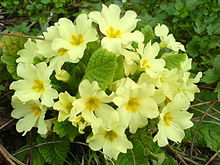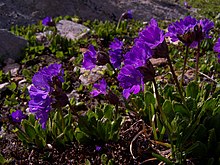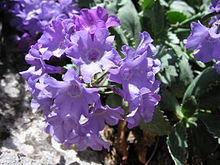Primula
| Primula | |
|---|---|

| |
| Primula vulgaris | |
| Scientific classification | |
| Kingdom: | Plantae |
| Clade: | Tracheophytes |
| Clade: | Angiosperms |
| Clade: | Eudicots |
| Clade: | Asterids |
| Order: | Ericales |
| Family: | Primulaceae |
| Subfamily: | Primuloideae |
| Genus: | Primula L. |
| Type species | |
| Primula veris L. | |
| Synonyms | |
| |
Primula /ˈprɪmjʊlə/[1] is a genus of mainly herbaceous[2] flowering plants in the family Primulaceae. They include the familiar wildflower of banks and verges, the primrose (P. vulgaris). Other common species are P. auricula (auricula), P. veris (cowslip) and P. elatior (oxlip). These species and many others are valued for their ornamental flowers. They have been extensively cultivated and hybridised - in the case of the primrose, for many hundreds of years. Primula are native to the temperate northern hemisphere, south into tropical mountains in Ethiopia, Indonesia and New Guinea, and in temperate southern South America. Almost half of the known species are from the Himalayas.[2]
Primula has over 500 species in traditional treatments, and more if certain related genera are included within its circumscription.[3]
Description[]
Primula is a complex and varied genus, with a range of habitats from alpine slopes to boggy meadows. Plants bloom mostly during the spring, with flowers often appearing in spherical umbels on stout stems arising from basal rosettes of leaves; their flowers can be purple, yellow, red, pink, blue, or white. Some species show a white mealy bloom (farina) on various parts of the plant.[2] Many species are adapted to alpine climates.
Taxonomy[]
Primula was known at least as early as the mediaeval herbalists, although first formally described as a genus by Linnaeus in 1753,[4] and later in 1754 in his Flora Anglica. Linnaeus described seven species of Primula. One of its earliest scientific treatments was that of Charles Darwin study of heterostyly in 1877 (The different forms of flowers on plants of the same species). Since then, heterostyly (and homostyly) have remained important considerations in the taxonomic classification of Primula.[5][6] Primula is a member of the Primulaceae family. The most complete treatment of the family, with nearly 1000 species arranged into 22 genera, was by Pax and Knuth in 1905.[7]
Phylogeny[]
Primula is the largest genus in the family Primulaceae, within which it is placed in the subfamily Primuloideae, being the nominative genus.[8]
The position of Primula within the family and its relationship to other genera is shown in this cladogram:
| Primulaceae s.l. |
| |||||||||||||||||||||||||||
Classification[]
The genus Dodecatheon originated from within Primula, so some authorities include the 14 species of Dodecatheon in Primula.[9]
Sections of genus Primula[]
The classification of the genus Primula has been investigated by botanists for over a century. As the genus is both large and diverse (with about 430–500 species), botanists have organized the species in various sub-generic groups. The most common is division into a series of thirty sections.[10][11] Some of these sections (e.g. Vernales, Auricula) contain many species; others contain only one.
- Amethystina
- Auricula
- Bullatae
- Candelabra
- Capitatae
- Carolinella
- Cortusoides
- Cuneifolia
- Denticulata
- Dryadifolia
- Farinosae
- Floribundae
- Grandis
- Malacoidea
- Malvacea
- Minutissimae
- Muscaroides
- Nivales
- Obconica
- Parryi
- Petiolares
- Pinnatae
- Pycnoloba
- Reinii
- Rotundifolia
- Sikkimensis
- Sinenses
- Soldanelloideae
- Souliei
- Vernales
Selected species[]



- (bluedome primrose)
- Primula allionii (Allioni's primrose)
- Primula alpicola (moonlight primrose)
- Primula amethystina
- Primula angustifolia (alpine primrose)
- (anise primrose)
- (boreal primrose)
- [15]
- (primevère à fleurs oranges)
- Primula auricula (auricula, bear's ear)
- Primula beesiana (candelabra primrose)
- [16]
- (northern primrose)
- Primula bracteosa
- Primula bulleyana (candelabra primrose)




- [17]
- Primula capillaris (Ruby Mountain primrose)
- Primula capitata
- Primula capitata ssp. mooreana
- Primula capitata ssp. crispata
- Primula carniolica[18] (Carniolan primrose)
- Primula chionantha
- Primula chasmophila
- Primula cockburniana
- (wedgeleaf primrose, pixie-eye primrose)
- Primula cusickiana (Cusick's primrose)
- Primula denticulata (drumstick primrose, Himalayan primrose)
- Primula deorum (Rila primrose, Rila cowslip, God's cowslip)
- (Greenland primrose)
- Primula elatior (oxlip, true oxlip, oxslip)
- Primula farinosa (birdseye primrose)
- [19]
- Primula florindae (Himalayan cowslip, Tibetan cowslip)
- Primula frondosa



- (long-flowered primrose, Haller's primrose)
- Primula hendersonii (broad-leaved shootingstar, Henderson's shootingstar, mosquito-bill, sailor caps)
- (stinking primrose)
- Primula hookeri
- (silvery primrose, mealy primrose)
- Primula japonica (Japanese primrose, Japanese cowslip)
- (Julia's primrose, purple primrose)
- Primula kisoana
- (Kitaibel's primrose)
- (birdseye primrose)
- [20]


- Primula lutea
- (largeleaf primrose)
- Primula malacoides (fairy primrose, baby primrose)
- Primula marginata (marginate primrose)
- [21]
- Primula melanops
- (dwarf primrose)
- Primula mistassinica (Mistassini primrose)
- [22]


- Primula nivalis (snowy primrose)
- Primula obconica (poison primrose, German primrose)



- [23]
- Primula parryi (Parry's primrose)
- [19]
- Primula poissonii
- Primula prolifera (glory-of-the-marsh)
- Primula pulverulenta (mealy cowslip)
- (arctic primrose)
- Primula rosea (Himalayan meadow primrose)
- Primula rusbyi (Rusby's primrose)
- (rock primrose)
- [24] (Scandinavian primrose)
- Primula scotica (Scottish primrose)
- Primula secundiflora
- Primula sieboldii (Japanese primrose)
- Primula sikkimensis (Sikkim cowslip)
- Primula sinensis (syn. P. praenitens)
- [25]
- Primula specuicola (alcove primrose, cave-dwelling primrose)
- (coastal primrose, strict primrose)
- Primula suffrutescens (Sierra primrose)
- Primula tanneri
- [26]
- [16]
- (Chukchi primrose)
- Primula veris (cowslip)
- [27] (yellow primrose)
- Primula vialii (wayside primrose, pagoda primrose, orchid primrose, poker primrose)
- Primula vulgaris (primrose)
- (Wollaston's primrose)
- (Wulfen's primrose)
Etymology[]
The word primula is the Latin feminine diminutive of primus, meaning first (prime), applied to flowers that are among the first to open in spring.[28]
Ecology[]
Primulas are used as a food plant by the Duke of Burgundy butterfly.[29]
Distribution and habitat[]
Although there are over 400 species of Primula, about 75% are found in the eastern Himalayan mountain chain and western China (Yunnan Province), constituting a centre of diversity. Other centres of diversity are a western Asian centre (Caucasus, European mountain ranges from the Pyrenees, through the Alps to the Carpathian Mountains), mountains of East Asia and those of western North America. Primula is found in mountainous or higher latitude zones of North America, Europe, and Asia, with extension into South America, Africa (mountains of Ethiopia) and tropical Asia (islands of Java and Sumatra).[5][8] About 25 species occur in North America (represented in five sections).[30]
Primula is found in the humid and moderate climate regions of the Northern Hemisphere, predominantly in the forest belt, plain meadows, Alpine lawns, and nival and meadow tundras.[8]
Garden hybrids and cultivars[]
Primula species have been extensively cultivated and hybridised, mainly derived from P. elatior, P. juliae, P. veris and P. vulgaris. Polyanthus (often called P. polyantha) is one such group of plants, which has produced a large variety of strains in all colours, usually grown as annuals or biennials and available as seeds or young plants.[31]
Another huge range of cultivars, known as auriculas, are derived from crosses between P. auricula and P. hirsuta (among others). Specialist nurseries and auricula societies[32] support the growing and showing of these choice strains.
AGM cultivars[]
The following hybrid varieties and cultivars have gained the Royal Horticultural Society's Award of Garden Merit:-[33]
- 'Broadwell Milkmaid' (auri)[34]
- Charisma series (prim)[35]
- 'Clarence Elliott' (auri)[36]
- Crescendo Series (poly)
- Danova Series (prim)[40]
- 'Danova Rose'[41]
- 'Francisca' (poly)[42]
- 'Guinevere' (poly)[43]
- Primula × loiseleurii 'Aire Mist' (auri)[44]
- Primula × pubescens (auri)[45]
- 'Tony' (auri)[46]
- 'Wanda' (prim)[47]
Hybrids[]
- Primula × kewensis = P. floribunda × P. verticillata (Kew primrose)[27]
- Primula × polyantha = P. veris × P. vulgaris (false oxlip, polyanthus primula)[48]
- Primula × pubescens = P. hirsuta × P. auricula
References[]
- ^ Sunset Western Garden Book. 1995. 606–607.
- ^ a b c RHS A-Z Encyclopedia of Garden Plants. United Kingdom: Dorling Kindersley. 2008. p. 1136. ISBN 978-1405332965.
- ^ Primula. Flora of North America.
- ^ Linnaeus 1753.
- ^ a b Mast et al 2001.
- ^ Gilmartin 2015.
- ^ Martins et al 2003.
- ^ a b c Kovtonyuk & Goncharov 2009.
- ^ Weakley, A. S. (2008). "Flora of the Carolinas, Virginia, and Georgia, and Surrounding Areas". UNC Herbarium, North Carolina Botanical Garden, University of North Carolina at Chapel Hill.
- ^ Ingwersen, Will (1986) [1978]. Ingwersen's Manual of Alpine Plants. Portland: Timber Press. ISBN 978-0-88192-026-0.
- ^ Green, Roy (1986) [1976]. Asiatic Primulas. Woking, Surrey, UK: Alpine Garden Society.
- ^ Primula: List of Records. Flora of China.
- ^ Primula: List of Records. Flora of North America.
- ^ GRIN Species Records of Primula. Archived 2015-09-24 at the Wayback Machine Germplasm Resources Information Network (GRIN).
- ^ Basak, S. K. and G. G. Maiti. 2000. Primula arunachalensis sp. nov. (Primulaceae) from the Eastern Himalaya. Acta Phytotax. Geobot. 51(1) 11-15.
- ^ a b Ming, H. C. and G. Y. Ying. (2003). Two new species of Primula (Primulaceae) from China. Novon 13 196-199.
- ^ Xun, G. and F. Rhui-cheng. (2003). Primula calyptrata, a new species in section Carolinella (Primulaceae) from Yunnan, China. Novon 13 193-95.
- ^ "The IUCN Red List of Threatened Species". IUCN Red List of Threatened Species. 24 June 2010. 24 June 2010. Retrieved 2018-11-15.
- ^ a b Hu, C. M. and G. Hao. (2011). New and noteworthy species of Primula (Primulaceae) from China. Edinburgh Journal of Botany 68(2) 297.
- ^ Li, R. and C. M. Hu. (2009). Primula lihengiana (Primulaceae), a new species from Yunnan, China. Annales Botanici Fennici 46(2) 130-32
- ^ Rankin, David W. H. (2012). "726. Primula Melanantha". Curtis's Botanical Magazine. 29: 18–33. doi:10.1111/j.1467-8748.2012.01768.x.
- ^ Rix, Martyn (2005). "529. Primula Moupinensis. Primulaceae". Curtis's Botanical Magazine. 22 (2): 119–123. doi:10.1111/j.1355-4905.2005.00477.x.
- ^ "The IUCN Red List of Threatened Species". IUCN Red List of Threatened Species. 10 September 2008. 10 September 2008. Retrieved 2018-11-15.
- ^ "The IUCN Red List of Threatened Species". IUCN Red List of Threatened Species. 23 June 2010. 23 June 2010. Retrieved 2018-11-15.
- ^ "The IUCN Red List of Threatened Species". IUCN Red List of Threatened Species. 13 January 2011. 13 January 2011. Retrieved 2018-11-15.
- ^ Chi-Ming, H. (1994). New taxa and combinations in Chinese Primulaceae. Novon 4(2) 103-105.
- ^ a b Primula verticillata (yellow primrose). Archived 2012-09-05 at the Wayback Machine Royal Botanic Gardens, Kew.
- ^ Coombes, Allen J. (2012). The A to Z of Plant Names. USA: Timber Press. pp. 312. ISBN 9781604691962.
- ^ "UK Butterflies - Larval Foodplants".
- ^ Kelso 1991.
- ^ Reader's Digest Encyclopedia of Garden Plants & Flowers, 2nd edition. United Kingdom: Reader's Digest Association. 1978.
- ^ "Welcome to The National Auricula & Primula Society: Midland & West Section". National Auricula Society. Retrieved 18 February 2021.
- ^ "AGM Plants - Ornamental" (PDF). Royal Horticultural Society. July 2017. p. 81. Retrieved 14 May 2018.
- ^ "Primula 'Broadwell Milkmaid'". RHS. Retrieved 17 February 2021.
- ^ "Primula 'Charisma Series'". RHS. Retrieved 17 February 2021.
- ^ "Primula 'Clarence Elliott'". RHS. Retrieved 17 February 2021.
- ^ "RHS Plant Selector - Primula 'Crescendo Blue Shades'". Retrieved 17 February 2021.
- ^ "RHS Plant Selector - Primula 'Crescendo Bright Red'". Retrieved 17 February 2021.
- ^ "RHS Plant Selector - Primula 'Crescendo Pink and Rose Shades'". Retrieved 17 February 2021.
- ^ "RHS Plant Selector - Primula Danova Series". Retrieved 17 February 2021.
- ^ "RHS Plant Selector - Primula 'Danova Rose'". Retrieved 17 February 2021.
- ^ "Primula 'Francisca'". RHS. Retrieved 17 February 2021.
- ^ "RHS Plant Selector - Primula 'Guinevere'". Retrieved 17 February 2021.
- ^ "Primula × loiseleurii 'Aire Mist'". RHS. Retrieved 17 February 2021.
- ^ "Primula × pubescens". RHS. Retrieved 17 February 2021.
- ^ "Primula 'Tony'". RHS. Retrieved 17 February 2021.
- ^ "RHS Plant Selector - Primula 'Wanda'". Retrieved 17 February 2021.
- ^ "Primula × polyantha". Germplasm Resources Information Network (GRIN). Agricultural Research Service (ARS), United States Department of Agriculture (USDA). Retrieved 12 December 2017.
Bibliography[]
- Linnaeus, Carl (1753). "Primula". Species Plantarum: exhibentes plantas rite cognitas, ad genera relatas, cum differentiis specificis, nominibus trivialibus, synonymis selectis, locis natalibus, secundum systema sexuale digestas. 1. Stockholm: Impensis Laurentii Salvii. pp. 142–144., see also Species Plantarum
- Gilmartin, Philip M. (2015). "On the origins of observations of heterostyly in Primula". New Phytologist. 208 (1): 39–51. doi:10.1111/nph.13558. PMID 26255981.
- Kelso, Sylvia (1991). "Taxonomy of Primula Sects. Aleuritia and Armerina in North America". Rhodora. 93 (873): 67–99. JSTOR 23312756.
- Kovtonyuk, N. K.; Goncharov, A. A. (June 2009). "Phylogenetic relationships in the genus Primula L. (Primulaceae) inferred from the ITS region sequences of nuclear rDNA". Russian Journal of Genetics. 45 (6): 663–670. doi:10.1134/S1022795409060052. S2CID 30118798.
- Martins, L.; Oberprieler, C.; Hellwig, F. H. (2003). "A phylogenetic analysis of Primulaceae s.l. based on internal transcribed spacer (ITS) DNA sequence data". Plant Systematics and Evolution. 237 (1–2): 75–85. doi:10.1007/s00606-002-0258-1. S2CID 43988431.
- Mast, Austin R.; Kelso, Sylvia; Richards, A. John; Lang, Daniela J.; Feller, Danielle M. S.; Conti, Elena (2001). "Phylogenetic Relationships in Primula L. and Related Genera (Primulaceae) Based on Noncoding Chloroplast DNA". International Journal of Plant Sciences. 162 (6): 1381–1400. doi:10.1086/323444. JSTOR 323444. S2CID 59929813.
- "The American Primrose Society". Retrieved 6 June 2021.
Species[]
- Basak, Sandip Kumar; Maiti, G. G. (2000). "Primula arunachalensis sp. nov. (Primulaceae) from the Eastern Himalaya". Acta Phytotaxonomica et Geobotanica. 51 (1): 11–15. doi:10.18942/bunruichiri.KJ00001077444.
- Ming, Hu Chi; Ying, Geng Yu (2003). "Two New Species of Primula (Primulaceae) from China" (PDF). Novon. 13 (2): 196–199. doi:10.2307/3393518. JSTOR 3393518.
- Fu, Kunjun; Ohba, Hideaki; Gilbert, Michael G. (2004). "Primula". Retrieved 4 June 2021., in Flora of China online vol. 15
- Little, R. John; McKinney, Landon E. (2003). "Primula". Flora of North America. New York: Oxford University Press. Retrieved 5 June 2021.
- GRIN (2021). "Species of Primula". U.S. National Plant Germplasm System (GRIN). Agricultural Research Service, USDA. Retrieved 6 June 2021.
External links[]
| Wikimedia Commons has media related to Primula. |
| Wikispecies has information related to Primula. |
- Primula
- Garden plants
- Primulaceae genera
- Taxa named by Carl Linnaeus

